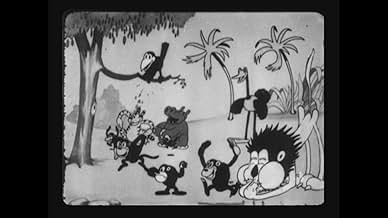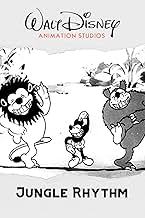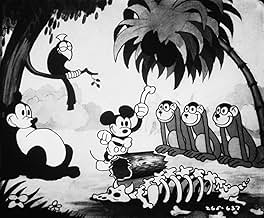Ajouter une intrigue dans votre langueMickey travels through a jungle riding an elephant and plays music with the animals.Mickey travels through a jungle riding an elephant and plays music with the animals.Mickey travels through a jungle riding an elephant and plays music with the animals.
- Réalisation
- Casting principal
Walt Disney
- Mickey Mouse
- (voix)
- (non crédité)
- …
Avis à la une
Inexplicably, this cartoon short finds Mickey in the jungle. And, like most of the early Mickey cartoons, there is an absence of dialog and lots of music. While today this all seems pretty campy, it was state of the art in its day.
For the most part, there really isn't any plot--just lots of jungle creatures parading past the screen--singing and dancing like they are on stage. Then, you get to hear Mickey sing--and it's pretty sad--but fortunately he mostly avoids singing and plays various animals like musical instruments--and abusing them a bit in the process.
Far from a classic, there is still an odd charm about this. And, interestingly, Mickey once again plays (among other songs) "Turkey in the Straw"--the same tune he played in "Steamboat Willie" the year before--which was the first cartoon with sound.
For the most part, there really isn't any plot--just lots of jungle creatures parading past the screen--singing and dancing like they are on stage. Then, you get to hear Mickey sing--and it's pretty sad--but fortunately he mostly avoids singing and plays various animals like musical instruments--and abusing them a bit in the process.
Far from a classic, there is still an odd charm about this. And, interestingly, Mickey once again plays (among other songs) "Turkey in the Straw"--the same tune he played in "Steamboat Willie" the year before--which was the first cartoon with sound.
A Walt Disney MICKEY MOUSE Cartoon.
Mickey shows true JUNGLE RHYTHM in the wilds, making merry music using the bodies of various & sundry creatures.
This early black & white Mouse film is almost completely plotless, its action entirely driven by the soundtrack. Music mavens will recognize 'The Blue Danube,' 'Aloha Oe' & 'Yankee Doodle' among other tunes.
Walt Disney (1901-1966) was always intrigued by drawings. As a lad in Marceline, Missouri, he sketched farm animals on scraps of paper; later, as an ambulance driver in France during the First World War, he drew figures on the sides of his vehicle. Back in Kansas City, along with artist Ub Iwerks, Walt developed a primitive animation studio that provided animated commercials and tiny cartoons for the local movie theaters. Always the innovator, his ALICE IN CARTOONLAND series broke ground in placing a live figure in a cartoon universe. Business reversals sent Disney & Iwerks to Hollywood in 1923, where Walt's older brother Roy became his lifelong business manager & counselor. When a mildly successful series with Oswald The Lucky Rabbit was snatched away by the distributor, the character of Mickey Mouse sprung into Walt's imagination, ensuring Disney's immortality. The happy arrival of sound technology made Mickey's screen debut, STEAMBOAT WILLIE (1928), a tremendous audience success with its use of synchronized music. The SILLY SYMPHONIES soon appeared, and Walt's growing crew of marvelously talented animators were quickly conquering new territory with full color, illusions of depth and radical advancements in personality development, an arena in which Walt's genius was unbeatable. Mickey's feisty, naughty behavior had captured millions of fans, but he was soon to be joined by other animated companions: temperamental Donald Duck, intellectually-challenged Goofy and energetic Pluto. All this was in preparation for Walt's grandest dream - feature length animated films. Against a blizzard of doomsayers, Walt persevered and over the next decades delighted children of all ages with the adventures of Snow White, Pinocchio, Dumbo, Bambi & Peter Pan. Walt never forgot that his fortunes were all started by a mouse, or that simplicity of message and lots of hard work always pay off.
Mickey shows true JUNGLE RHYTHM in the wilds, making merry music using the bodies of various & sundry creatures.
This early black & white Mouse film is almost completely plotless, its action entirely driven by the soundtrack. Music mavens will recognize 'The Blue Danube,' 'Aloha Oe' & 'Yankee Doodle' among other tunes.
Walt Disney (1901-1966) was always intrigued by drawings. As a lad in Marceline, Missouri, he sketched farm animals on scraps of paper; later, as an ambulance driver in France during the First World War, he drew figures on the sides of his vehicle. Back in Kansas City, along with artist Ub Iwerks, Walt developed a primitive animation studio that provided animated commercials and tiny cartoons for the local movie theaters. Always the innovator, his ALICE IN CARTOONLAND series broke ground in placing a live figure in a cartoon universe. Business reversals sent Disney & Iwerks to Hollywood in 1923, where Walt's older brother Roy became his lifelong business manager & counselor. When a mildly successful series with Oswald The Lucky Rabbit was snatched away by the distributor, the character of Mickey Mouse sprung into Walt's imagination, ensuring Disney's immortality. The happy arrival of sound technology made Mickey's screen debut, STEAMBOAT WILLIE (1928), a tremendous audience success with its use of synchronized music. The SILLY SYMPHONIES soon appeared, and Walt's growing crew of marvelously talented animators were quickly conquering new territory with full color, illusions of depth and radical advancements in personality development, an arena in which Walt's genius was unbeatable. Mickey's feisty, naughty behavior had captured millions of fans, but he was soon to be joined by other animated companions: temperamental Donald Duck, intellectually-challenged Goofy and energetic Pluto. All this was in preparation for Walt's grandest dream - feature length animated films. Against a blizzard of doomsayers, Walt persevered and over the next decades delighted children of all ages with the adventures of Snow White, Pinocchio, Dumbo, Bambi & Peter Pan. Walt never forgot that his fortunes were all started by a mouse, or that simplicity of message and lots of hard work always pay off.
This is not a bad little musical, with Mickey playing all sorts of instruments with a band of animals in the jungle. There's quite a bit of toe-tapping music, including the Blue Danube, Turkey in the Straw, Aloha 'Oe, and Yankee Doodle.
There's really not plot to the cartoon, just plenty of songs and dances.
Grade B-
There's really not plot to the cartoon, just plenty of songs and dances.
Grade B-
By all means this is not Mickey's best, but is fun and charming still. Some of the backgrounds have a somewhat sparse and primitive look, and the cartoon is virtually plot-less with an abrupt ending. However, the character designs do flow well especially with the lion and also the jungle cat's cute facial expressions. The music is energetic and very catchy, it was nice to hear Turkey in the Straw again, and the dancing shows nifty choreography and flowing movement especially with the lion's hula dance. There are some fun gags, such as Mickey grabbing a branch off a tree and starting to play it like a saxophone and with the Monkeys. Mickey is very likable as ever, and the animals are colourful characters in their own right. Overall, a charming and amusing short if not one of Mickey's best. 8/10 Bethany Cox
Tiger dances, monkeys dance, birds dance, mickey dances, and that's the whole story. Maybe it was good in its day, but its length might still be a problem. A film that features only music and dancing should not be long, but it keeps repeating it again and again to an extent that it becomes boring.
Le saviez-vous
- AnecdotesThe Disney Channel once banned this cartoon, thinking it contained cannibalistic caricatures.
- ConnexionsFeatured in Le Club Mickey: Guest Star Day: Firehouse Five Plus Two (1955)
- Bandes originalesAloha Oe
Written by Queen Liliuokalani
Meilleurs choix
Connectez-vous pour évaluer et suivre la liste de favoris afin de recevoir des recommandations personnalisées
Détails
- Durée7 minutes
- Couleur
- Rapport de forme
- 1.37 : 1
Contribuer à cette page
Suggérer une modification ou ajouter du contenu manquant

Lacune principale
By what name was Les rythmes de la jungle (1929) officially released in Canada in English?
Répondre



